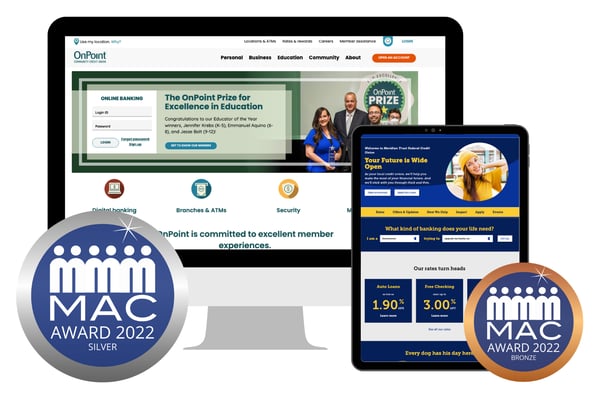The 3 Key Questions About Measuring ROI for your Credit Union Website

This article originally appeared in CU Insight.
If your credit union website follows the trends we’ve noticed across our client accounts, it’s seen a lot of traffic and activity in 2020—almost certainly more than any other year. But as we head into 2021, are you equipped with the tools, resources, and budget to truly realize the potential of your digital branch?
Throughout a number of lively discussions we’ve had with our clients about this very topic, three clear questions have emerged:
1. How do I get the data I need?
Even though Google Analytics and other tools present us with an overwhelming amount of data, it’s not always the data we need, even when it’s customized by an expert. Because credit unions contract with so many third-party vendors, one of the primary challenges that credit union marketing teams wrestle with is the ability to track the complete “buyer journey” — from the action that leads a prospect to your site to an application approval and/or a funded loan. Equally important is the ability to track where prospects are dropping off along the way.
At my company, we’ve identified three tiers of analytics reporting: 1) traffic and engagement analytics, 2) activity and click-through analytics, and 3) cross-domain conversion analytics. The first level requires little to no custom configuration, and while it by no means paints a complete picture, it can be valuable for a quick “health check” of your site, helping you to monitor traffic volume, engagement levels, top product pages, insite search results, referral sources, and more.
The second level includes more custom configuration to measure activities like button clicks, external link clicks, online banking logins, contact form submissions, and file downloads. Data on these activities gives you a more complete picture of what visitors are actually doing on your site, including where they are clicking and which off-site application forms, tools, and platforms they are accessing.
Still, even at this level, we don’t have much sense of what visitors are doing once they leave your website. Are they actually submitting the applications? That’s where cross-domain tracking comes in. You can pull in data from your third-party tools to get to that complete buyer journey, and to assess where the friction points might lie. For instance, perhaps you find that clicks from your website to your credit card application are increasing, but online credit card application submissions are on a downward trend, perhaps indicating a disconnect between a visitor’s expectations when they click an “Apply Now” button and what they find when they get there.
This most advanced level allows you to provide the data that your CFO is most likely to care about: total loan and new member volume for your “digital branch,” including the digital share for total loan and member growth, as well as performance trends for each specific product and how they are impacted by campaigns, website upgrades, or 3rd-party tool improvements.
Of course, just having access to the data doesn’t mean it’s always clear how to take the next step. That brings us to question 2:
2. What do I do with the data I have?
Even when you’re able to access valuable data, you may not always know what to do with it. Or, you simply may not have the bandwidth to take advantage of it. Many of our clients are well aware, for example, of the opportunities presented by personalization and marketing automation. At the same time, the seemingly infinite data points automation tools can track and respond to is enough to make one’s head spin. So we know that Member A visited your auto loan page twice over the last month and your mortgage refinance page once. What now?
Our best advice is to start small and begin with the end in mind. Think of a single goal for a single target audience and work backwards. Maybe you want to more effectively cross-sell credit cards to 18-24 year-olds who have checking accounts. What behavior should you track? What data points will help you deliver the most effective personalized experience? Which data points will trigger a follow-up email or retargeting campaign?
We’ve seen a number of clients invest in a marketing automation tool and then feel so overwhelmed that they put off using it. Or, they start capturing leads with no real strategy for what to do with these leads once they get them. Remember: just because you have the data doesn’t mean you have to use it all at once!
3. How do I convince stakeholders to allocate resources toward getting the right data and using it to drive decisions?
Data helps marketing teams assess their strategies, make more informed decisions, and quantify returns on their investments. In that sense, data can be helpful for convincing stakeholders to invest more in what’s working or to try an alternate route. But the irony is that gathering, analyzing, and acting on data requires its own investments—of time, resources, and expertise. Credit union marketers must not only convince stakeholders to use data to inform ROI, but first to invest in getting access to the data you need.
It’s safe to say that credit unions have been sold on the value of their digital properties — their website, online banking platform, and online application tools. What’s missing is a clear understanding of what role these digital properties truly play in the financial health of your credit union. They are often viewed as a way to appeal to younger generations and offer more convenience to prospects and members.
But what if you looked at your digital branch as a standalone part of your credit union that needs to turn a profit just like your individual branches? You’ve probably heard the adage that “you can’t improve what you can’t measure.” This is definitely true in your physical branches, where you’re tracking loans, deposits, new members, transactions, etc. to identify which branches are performing well and which are under-performing.
Many credit unions have yet to carry that same mentality over to their digital properties. A true digital branch is a profit center with its own income statement. You’d be hard-pressed to find a CFO who doesn’t believe that it’s worth the time to create an income statement for any given credit union branch, however you arrive at the numbers. Making the case for treating your digital branch as a profit center with its own financial statements may help stakeholders understand how important it is to allocate resources toward measuring its performance.
In 2020, as more and more people have been routed to digital tools, one of our clients has seen a 35% increase in clicks to apply online, another a 420% increase in clicks to download mobile apps, and another a 118% increase in online banking logins. It’s safe to assume that many members who previously frequented branches will continue to leverage your digital branch even after COVID ends because of an increased comfort level with digital tools.
That makes measuring your digital ROI more important than ever. The first step might involve a mindset shift when it comes to viewing your digital branch not just as a convenient service, but as an investment with the potential to turn a profit. Then you’ll need a plan for accessing the data you need, working backwards from your broader marketing goals, and a strategy for incrementally leveraging this data.
Just remember — determining digital ROI is an ongoing challenge that you’re not going to solve in one go. But the sooner you get started, the better chance you’ll have of getting the tools, expertise, and resources you need to truly realize the potential of your digital branch.


